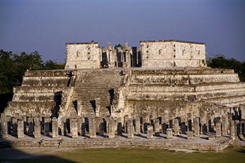题目内容
【题目】假设你是红星中学高二(1)班的学生李华。下面四幅图描述了上周五你在放学路上,撞倒一位骑车老人并实施救助的过程。请根据图片的先后顺序,写一篇英文周记。
注意:
1.文章的开头已为你写好;
2.词数不少于60。

Last Friday _____________________________________________________________
_____________________________________________________________________
_____________________________________________________________________
【答案】Last Friday, as usual I rode my bike home. But at a crossing, I accidentally knocked an old man off his bike. I hurried over and found his leg was injured. Nervous and worried, I called my mom and told her what had happened. We decided to take him to the hospital first.
Soon after we arrived at the hospital, my mother came. The doctor gave the old man a thorough examination. To our delight and relief, there was nothing seriously wrong with him. We thanked the doctor and left.
After that, we went back to where the bike was parked only to find it didn’t work. So I immediately found a repairman to get it fixed. Before the old man left, my mom offered him our cell phone number in case he needed to contact us. Then the old man got on his bike and we waved goodbye to each other.
The accident made me realize that in the first place we should be careful to avoid accidents, but once they occur, we should take responsibility.
【解析】
试题解析:在写作的时候考生首先要观察四张图的内容,然后按照图片中的内容,展开对事情发展的先后顺序的联想,以便自己能够很好地抓住图片中所发生的事情和主要内容进行写作。同时,由于图片描述的是一件事,故考生还要注意的是在写作过程中所运用的时态要以一般过去时为主。除此以外,要注意写作过程中注意使用平时学到的短语和句型,注意行文的连贯和逻辑性。

【题目】阅读理解。
阅读短文,从每题所给的四个选项(A、B、C和D)中,选出最佳选项。
|
“BEST PRODUCT WE’VE EVER SEEN”-THIS REALLY WORKS-ON SALE NOW Need to lower your cholesterol(胆固醉)?We strongly recommend CholestrolblockTM. This really works, and now is the best time to buy,because of a special offer for the first 250 customers only for a limited time. * Takes cholesterol out of food,no matter what you eat. * Clinically demonstrated effective in university and hospital testing. * Lowers cholesterol absorption up to 42% or more. * “NO SIDE EFFECTS unlike Liptor, Zocor,Crests&other commonly prescribed(处方的) medications-safe and effective. * “Outsells all other brands on Internet every month. LIMITED TIME ONLY一Try Cholesterol Watchers free with purchase. |
【1】If you happen to be the 200th customer to buy Cholesterolblock, you will .
A. be able to buy it at a low price
B. be the luckiest one online
C. try it free of charge
D. change your diet
【2】Liptor,Zocor,Crestor are .
A. diseases B. side effects
C. medicines D. cholesterol
【3】Where can you most probably read this passage?
A. In a travel guide book.
B. On a university bulletin board(布告牌).
C. In a health magazine.
D. In a doctor’s prescription.





